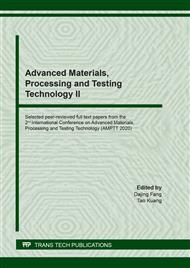[1]
WANG S T, LIU K S, YAO X, et al. Bioinspired Surfaces with Superwettability: New Insight on Theory, Design, and Applications[J]. Chemical Reviews, 2015, 115: 8230−8293.
DOI: 10.1021/cr400083y
Google Scholar
[2]
YOUNG T. An Essay on the Cohesion of Fluids[J]. Philosophical Transactions of the Royal Society of London, 1805, 95: 65–87.
DOI: 10.1098/rstl.1805.0005
Google Scholar
[3]
WENZEL R N. Resistance of Solid Surfaces to Wetting by Water[J]. Industrial & Engineering Chemistry, 1936, 28: 988–994.
DOI: 10.1021/ie50320a024
Google Scholar
[4]
CASSIE A B D, BAXTER S. Wettability of Porous Surfaces[J]. Transactions of the Faraday Society, 1944, 40: 546–551.
DOI: 10.1039/tf9444000546
Google Scholar
[5]
WANG S T, JIANG L. Definition of Superhydrophobic States[J]. Advanced Materials, 2007, 19: 3423–3424.
Google Scholar
[6]
BARTHLOTT W, NEINHUIS C. Purity of the Sacred Lotus, or Escape from Contamination in Biological Surfaces[J]. Planta, 1997, 202: 1–8.
DOI: 10.1007/s004250050096
Google Scholar
[7]
PATANKAR N A. Mimicking the Lotus Effect: Influence of Double Roughness Structures and Slender Pillars[J]. Langmuir, 2004, 20: 8209–8213.
DOI: 10.1021/la048629t
Google Scholar
[8]
BHUSHAN B, JUNG Y C, KOCH K. Micro-, Nano- and Hierarchical Structures for Superhydrophobicity, Self-Cleaning and Low Adhesion[J]. Philosophical Transactions of the Royal Society A Mathematical Physical and Engineering Science, 2009, 367: 1631–1672.
DOI: 10.1098/rsta.2009.0014
Google Scholar
[9]
BHUSHAN B, JUNG Y C. Natural and Biomimetic Artificial Surfaces for Superhydrophobicity, Self-Cleaning, Low Adhesion, and Drag Reduction[J]. Progress in Materials Science, 2011, 56: 1–108.
DOI: 10.1016/j.pmatsci.2010.04.003
Google Scholar
[10]
JIANG L, FENG L, LI S H, et al. Superhydrophobic Surface: from Natural to Artificial[J]. Advanced Materials, 2002, 14: 1857–1860.
Google Scholar
[11]
KENNEDY R J. Directional Water-Shedding Properties of Feathers[J]. Nature, 1970, 227: 736–737.
DOI: 10.1038/227736a0
Google Scholar
[12]
GAO X F, ZHENG Y M, JIANG L. Directional Adhesion of Superhydrophobic Butterfly Wings[J]. Soft Matter, 2007, 3: 178–182.
DOI: 10.1039/b612667g
Google Scholar
[13]
LI S, Huang J, CHEN Z, et al. A Review on Special Wettability Textiles: Theoretical Models, Fabrication Technologies and Multifunctional Applications[J]. Journal of Materials Chemistry A, 2017, 5: 31–55.
DOI: 10.1039/c6ta07984a
Google Scholar
[14]
YANG Z Q, WANG L, SUN W, et al. Superhydrophobic Epoxy Coating Modified by Fluorographene Used for Anti-Corrosion and Self-Cleaning[J]. Applied Surface Science, 2017, 401: 146–155.
DOI: 10.1016/j.apsusc.2017.01.009
Google Scholar
[15]
SHI F, NIU J, LIU J, et al. Towards Understanding Why a Superhydrophobic Coating Is Needed by Water Striders[J]. Advanced Materials, 2007, 19: 2257–2261.
DOI: 10.1002/adma.200700752
Google Scholar
[16]
MCHALE G, SHIRTCLIFFE N J, EVANS C R, et al. Terminal Velocity and Drag Reduction Measurements on Superhydrophobic Spheres[J]. Applied Physics Letter, 2009, 94: 064104–064107.
DOI: 10.1063/1.3081420
Google Scholar
[17]
WATANABE K, UDAGAWA Y, UDAGAWA H. Drag Reduction of Newtonian Fluid in a Circular Pipe with a Highly Water-Repellent Wall[J]. Journal of Fluid Mechanics, 1999, 381: 225–238.
DOI: 10.1017/s0022112098003747
Google Scholar
[18]
MILJKOVIC N, ENRIGHT R, NAM Y. Jumping-Droplet-Enhanced Condensation on Scalable Superhydrophobic Nanostructured Surfaces[J]. Nano Letters, 2013, 13: 179–187.
DOI: 10.1021/nl303835d
Google Scholar
[19]
MENINI R, GHALMI Z, FARZANEH M. Highly Resistant Icephobic Coatings on Aluminum Alloys[J]. Cold Region Science and Technology, 2011, 65: 65–69.
DOI: 10.1016/j.coldregions.2010.03.004
Google Scholar
[20]
WANG F, LI C, LV Y, et al. Ice Accretion on Superhydrophobic Aluminum Surfaces under Low-Temperature Conditions[J]. Cold Region Science and Technology, 2010, 62: 29–33.
DOI: 10.1016/j.coldregions.2010.02.005
Google Scholar
[21]
WANG S, ZHANG W, YU X, et al. Sprayable Superhydrophobic Nano-Chains Coating with Continuous Self-Jumping of Dew and Melting Frost[J]. Scientific Reports, 2017, 7: 40300.
DOI: 10.1038/srep40300
Google Scholar
[22]
LARMOUR I A, BELL S E J, SAUNDERS G C. Remarkably Simple Fabrication of Superhydrophobic Surfaces Using Electroless Galvanic Deposition[J]. Angewandte Chemie International Edition, 2007, 46: 1710–1712.
DOI: 10.1002/anie.200604596
Google Scholar
[23]
WANG Y H, WANG W, ZHONG L, et al. Superhydrophobic Surface on Pure Magnesium Substrate by Wet Chemical Method[J]. Applied Surface Science, 2010, 256: 3837–3840.
DOI: 10.1016/j.apsusc.2010.01.037
Google Scholar
[24]
YIN B, FANG L, HUA J, et al. Preparation and Properties of Superhydrophobic Coating on Magnesium Alloy[J]. Applied Surface Science, 2010, 257: 1666–1671.
DOI: 10.1016/j.apsusc.2010.08.119
Google Scholar
[25]
WANG J, LI D, GAO R, et al. Construction of Superhydrophobic Hydromagnesite Films on the Mg Alloy[J]. Materials Chemistry and Physics, 2011, 129: 154–160.
DOI: 10.1016/j.matchemphys.2011.03.065
Google Scholar
[26]
ZANG D, ZHU R, WU C, et al. Fabrication of Stable Superhydrophobic Surface with Improved Anticorrosion Property on Magnesium Alloy[J]. Scripta Materialia, 2013, 69: 614–617.
DOI: 10.1016/j.scriptamat.2013.07.014
Google Scholar
[27]
YAMADA R, TADA H. Manipulation of Droplets by Dynamically Controlled Wetting Gradients[J]. Langmuir, 2005, 21: 4254–4256.
DOI: 10.1021/la046982t
Google Scholar
[28]
FENG L, ZHANG Z Y, MAI Z H, et al. A Superhydrophobic and Superoleophilic Coating Mesh Film for the Separation of Oil and Water[J]. Angewandte Chemie International Edition, 2004, 43: 2012–(2014).
Google Scholar
[29]
GUIX M, OROZCO J, GARCIA M, et al. Superhydrophobic Alkanethiol Coated Microsubmarines for Effective Removal of Oil[J]. ACS Nano, 2012, 6: 4445–4451.
DOI: 10.1021/nn301175b
Google Scholar
[30]
XUE Z X, Wang S T, LIN L, et al. A Novel Superhydrophilic and Underwater Superoleophobic Hydrogel Coated Mesh for Oil/Water Separation[J]. Advanced Materials, 2011, 23: 4270–4273.
DOI: 10.1002/adma.201102616
Google Scholar
[31]
ZANG D M, WU C X, ZHU R W, et al. Porous Copper Surfaces with Improved Superhydrophobicity under Oil and Their Application in Oil Separation and Capture from Water[J]. Chemical Communications, 2013, 49: 8410–8412.
DOI: 10.1039/c3cc43536a
Google Scholar
[32]
TESLER A B, KIM P, KOLLE S, et al. Extremely Durable Biofouling-Resistant Metallic Surfaces Based on Electrodeposited Nanoporous Tungstite Films on Steel[J]. Nature Communications, 2015, 6: 8649.
DOI: 10.1038/ncomms9649
Google Scholar
[33]
HIZAL F, RUNGRAENG N, LEE J, et al. Nanoengineered Superhydrophobic Surfaces of Aluminum with Extremely Low Bacterial Adhesivity[J]. ACS Applied Materials and Interfaces, 2017, 9 (13): 12118–12129.
DOI: 10.1021/acsami.7b01322
Google Scholar
[34]
SU B, TIAN Y, JIANG L. Bioinspired Interfaces with Superwettability: From Materials to Chemistry[J]. Journal of the American Chemical Society, 2016, 138: 1727−1748.
DOI: 10.1021/jacs.5b12728
Google Scholar


